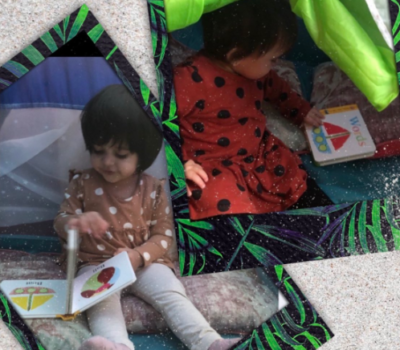


Our team sorts through all blog submissions to place them in the categories they fit the most - meaning it's never been simpler to gain advice and new knowledge for topics most important for you. This is why we have created this straight-forward guide to help you navigate our system.


And there you have it! Now your collection of blogs are catered to your chosen topics and are ready for you to explore. Plus, if you frequently return to the same categories you can bookmark your current URL and we will save your choices on return. Happy Reading!

Not all children gain the maximum benefit from structured, universal learning methods. For some, having a range of unique learning opportunities helps them to develop the core skills needed as they progress through the educational system and enter into the world of work. One popular method is sensory learning, which encourages kids to stimulate their motor skills and cognitive functions in a constructive, hands-on way.
In this guide, we’ll explore exactly what sensory learning is and discuss some of the benefits and potential pitfalls of this style. With so many different ways to introduce sensory learning and play into the classroom, could it be the right approach for you?
Sensory learning enables children to explore the world around them and to experience things firsthand. By utilising their senses, kids can experience new environments, materials and textures that help enrich their understanding of the world. This type of learning, which forgoes the traditional lecture-style teaching approach, encourages critical thinking and insights into the cause-and-effect relationships between things that are experienced through sight, sound, touch, smell, and taste.
Sensory learning encourages a child’s exploration of the environment without fear or consequence. As such, it helps kids understand more effectively how things work and become comfortable in different environments. Plus, kids typically find this way of learning more enjoyable – giving them an enhanced enthusiasm for education.
While sensory learning won’t suit every child, it can offer many benefits to those who find it engaging. Sensory learning allows children to use their five senses to better conceptualise thoughts, explore unfamiliar concepts, and reinforce knowledge in ways that traditional methods can’t. It also lets kids unleash their creativity in new and imaginative ways, allowing them to experience exciting challenges that call for innovative solutions.
Additionally, sensory or experiential learning may help some children to remember concepts longer than traditional textbook-based courses, which can help them form a strong foundation of skills well into adulthood. Overall, sensory learning is an invaluable advantage that all kids should experience during their education.
Sensory learning has become an increasingly popular way of teaching children, but it could have drawbacks. For instance, while this method is successful in teaching some kids who struggle to learn in traditional ways, it might also have the potential of creating dependence on sensory input and therefore keep the student from developing functional independence.
What’s more, using tactile or auditory methods exclusively can be costly and time-consuming, making it a less accessible option for all students and educational institutions. As a result, educators must weigh the pros and cons carefully when deciding whether or not to incorporate sensory learning into their curriculum.
To get the maximum benefit from sensory learning, it should be used alongside other methods, to provide children with a more balanced approach to learning. By using their senses as a tool for learning, children are able to form more meaningful connections with the natural world from an early age, which benefits both the planet and the children themselves.

The author

Read more

Read more

Read more

Read more

Read more

Read more

Read more

Read more


Are you looking for solutions? Let us help fund them! Nexus Education is a community of over 11,000 schools that come together to share best practise, ideas and CPD via online channels and free to attend events. Nexus also offers funding to all school groups in the UK via nexus-education.com


Established in 2011, One Education is a company at the heart of the education world, supporting over 600 schools and academies. Our unique appeal as a provider is in the breadth and synergy of the services we offer, supporting school leaders, teachers and support staff to achieve the best possible outcomes for their pupils and staff.

School Space is a social enterprise that has empowered schools for over 12 years through their profitable and hassle-free lettings services. So far, they’ve generated over £5 million in revenue for education, helping to connect over 200 schools with their local communities.


Unify is an online sales and marketing tool that allows users to create tailored personalised documents in moments.


There’s nothing special about the energy we sell. In fact, it’s exactly the same energy as all our competitors provide. But there is something special about the way we do it. Where others complicate the process, we simplify it. Where others confuse customers with hidden terms, we’re an open book. And where others do all they can to make as much money from their customers as possible, we do all we can to make as little. Everything we do, we do it differently. Our customers are a privilege. One we’ll never take advantage of.


Securus provide market-leading monitoring solutions to safeguard students on ALL devices both online and offline. We also offer a full monitoring service, where we carry out the monitoring on behalf of the school, freeing up valuable staff resources. From the smallest school to large MAT groups, Securus offers safeguarding protection for all!


Bodet Time offers dedicated solutions to education through lockdown alerts, class change systems, PA and synchronised clock systems. Improving time efficiency of the working and school day; ensuring safety through lockdown alerts; increasing communication with customised broadcast alerts.


Robotical makes Marty the Robot - a walking, dancing coding robot that makes programming fun and engaging for learners as young as 5. Our robots come with a full Learning Platform that has complete teaching resources, to make lesson planning a breeze.